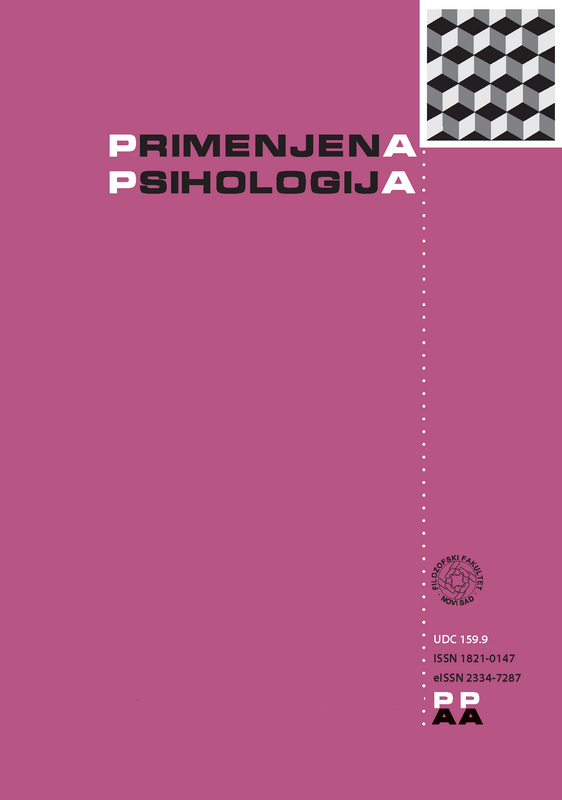THE BIG FIVE PERSONALITY TRAITS AND SOCIODEMOGRAPHICS AS PREDICTORS OF MAJOR LIFE GOALS
DOI:
https://doi.org/10.19090/pp.2016.1.23-40Ključne reči:
major life goals, personality traits, Big Five, charac- teristic adaptationsApstrakt
The aim of this research was to investigate relations between major life goals and the Big Five personality traits. A total of 599 participants in the 16-72 age range completed the Big Five Inventory (BFI) and the Life Goal Questionnaire, which was designed for the purposes of this research. The principal component analysis showed the following seven life goal dimensions: Well-Being, Family Relations, Autonomy, Career, Relationships, Friendship, and Education. Psychometric and descriptive characteristics of each component were examined. Results of hierarchical regression analyses indicated a statistically significant, yet relatively small contribution of personality traits to prediction of major life goals, above and beyond the variance explained by the demographic predictor variables. The results were interpreted in terms of the findings of previous research, as well as considering the role of major life goals as characteristic adaptations within the Big Five model.Reference
Asendorpf, J. B., & Van Aken, M. A. (2003). Personality–relationship transaction in adolescence: Core versus surface personality characteristics. Journal of Personality, 71, 629‒666. doi:10.1111/1467-6494.7104005
Benet, V., & Waller, N. G. (1995). The Big Seven factor model of personality description: Evidence for its cross-cultural generality in a Spanish sample. Journal of Personality and Social Psychology, 69, 701‒718.
Berings, D., De Fruyt, F., & Bouwen, R. (2004). Work values and personality traits as predictors of enterprising and social vocational interests. Personality and Individual Differences, 36, 349‒364. doi:10.1016/S0191-8869(03)00101-6
Bleidorn, W., Kandler, C., Hülsheger, U. R., Riemann, R., Angleitner, A., & Spinath, F. M. (2010). Nature and nurture of the interplay between personality traits and major life goals. Journal of Personality and Social Psychology, 99, 366‒379. doi:10.1037/a0019982
Cohen, J. (1988). Statistical power analysis for the behavioral sciences (2nd ed.). Hillsdale, NJ: Erlbaum.
Čolović, P., Mitrović, D. i Smederevac, S. (2005). Evaluacija modela Pet velikih u našoj kulturi primenom upitnika FIBI. Psihologija, 38, 55‒76.
Costa, P., & McCrae, R. (1988). From catalog to classification: Murray’s needs and the five-factor model. Journal of Personality and Social Psychology, 55, 258‒265. doi:10.1037/0022-3514.55.2.258
Davids, E. L., & Roman, N. V. (2013). Does family structure matter? Comparing the life goals and aspirations of learners in secondary schools. South African Journal of Education, 33, 1‒12. doi:10.15700/201503070745
Denissen, J., & Penke, L. (2008). Motivational individual reaction norms underlying the Five-Factor model of personality: First steps towards a theory-based conceptual framework. Journal of Research in Personality, 42, 1285‒1302. doi:10.1016/j.jrp.2008.04.002
Ekehammar, B., & Akrami, N. (2007). Personality and prejudice: From Big Five personality factors to facets. Journal of Personality, 75, 899‒926. doi:10.1111/ j.1467-6494.2007.00460.x
Ekehammar, B., Akrami, N., Gylje, M., & Zakrisson, I. (2004). What matters most to prejudice: Big five personality, social dominance orientation, or right-wing authoritarianism? European Journal of Personality, 18, 463‒482. doi:10.1002/ per.526
Field, A. (2000). Discovering statistics using IBM SPSS for Windows. London: Sage publications.
Gerber, A. S., Huber, G. A., Doherty, D., & Dowling, C. M. (2011). The big five personality traits in the political arena. Annual Review of Political Science, 14, 265‒287. doi:10.1146/annurev-polisci-051010-111659
Goldberg, L. R. (1981). Language and individual differences: The search for universals in personality lexicons. In L. Wheeler (Ed.), Review of personality and social psychology (Vol. 2, pp. 141‒165). Beverly Hills, CA: Sage.
Goldberg, L. R. (1993). The structure of phenotypic personality traits. American Psychologist, 48, 26‒34. doi:10.1037/0003-066x.48.1.26
Grahovac, B. (2011). Relacije koncepta rigidnosti sa dimenzijama ličnosti merenim upitnikom Velikih pet plus dva (VP+2). Primenjena psihologija, 4, 53‒67.
Haslam, N., Whelan, J., & Bastian, B. (2009). Big five traits mediate associations between values and subjective well-being. Personality and Individual Differences, 46, 40‒42. doi:10.1016/j.paid.2008.09.001
Horn, J. L. (1965). A rationale and test for the number of factors in factor analysis. Psychometrika, 30, 179‒185. doi:10.1007/BF02289447
John, O. P., & Srivastava, S. (1999). The Big Five trait taxonomy: History, measurement, and theoretical perspectives. In L. A. Pervin & O. P. John (Eds.), Handbook of personality: Theory and research (pp. 102–138). New York: Guilford Press.
John, O. P., Donahue, E. M., & Kentle, R. L. (1991). The Big Five inventory – versions 4a and 54. Berkley, CA: University of California, Berkley, Institute of Personality and Social Research.
Jolliffe, I. T. (1986). Principal Component Analysis. New York: Springer-Verlag. doi:10.1007/978-1-4757-1904-8
Kaiser, R. T., & Ozer, D. J. (1994). The strucure of personal goals and their relation to personality traits. Paper presented at the 102nd Convention of the American Psychological Association, Los Angeles, USA.
Kardum, I., Hudek-Knežević, J., & Kola, A. (2005). Odnos između osjećaja koherentnosti, dimenzija petofaktorskog modela ličnosti i subjektivnih zdravstvenih ishoda. Psihologijske teme, 14, 79‒94.
King, L. A. (1995). Wishes, motives, goals, and personal memories: Relations of measures of human motivation. Journal of Personality, 63, 985‒1007. doi:10.1111/j.1467-6494.1995.tb00323.x
Laidra, K., Pullmann, H., & Allik, J. (2007). Personality and intelligence as predictors of academic achievement: A cross-sectional study from elementary to secondary school. Personality and Individual Differences, 42, 441‒451. doi:10.1016/j.paid.2006.08.001
Lewis, G. J., & Bates, T. C. (2011). From left to right: How the personality system allows basic traits to influence politics via characteristic moral adaptations. British Journal of Psychology, 102, 546‒558. doi:10.1111/j.2044- 8295.2011.02016.x
Löckenhoff, C. E., Terracciano, A., Ferrucci, L., & Costa, P. T. (2012). Five-factor personality traits and age trajectories of self-rated health: The role of question framing. Journal of Personality, 80, 375‒401. doi:10.1111/j.1467- 6494.2011.00724.x
Mackinnon, S. P., & Sherry, S. B. (2012). Perfectionistic self-presentation mediates the relationship between perfectionistic concerns and subjective well-being: A three-wave longitudinal study. Personality and Individual Differences, 53, 22‒28. doi:10.1016/j.paid.2012.02.010
McAdams, D. P., & Pals, J. L. (2006). A new Big Five: Fundamental principles for an integrative science of personality. American Psychologist, 61, 204‒217. doi:10.1037/0003-066X.61.3.204
McAdams, D. P., Anyidoho, N. A., Brown, C., Huang, Y. T., Kaplan, B., & Machado, M. A. (2004). Traits and stories: Links between dispositional and narrative features of personality. Journal of Personality, 72, 761‒784. doi:10.1111/ j.0022-3506.2004.00279.x
McCrae, R. R., Costa Jr, P. T., Ostendorf, F., Angleitner, A., Hřebíčková, M., Avia, M. D., . . . Saunders, P. R. (2000). Nature over nurture: Temperament, personality, and life span development. Journal of Personality and Social Psychology, 78, 173–186. doi:10.1037/0022-3514.78.1.173
McCrae, R., & Costa, P., (2008). The five-factor theory of personality. In O. P. John, R. W. Robins, & L. A. Pervin (Eds.), Handbook of personality: Theory and research (3rd ed., pp. 1–58). New York, NY: Guilford Press.
McCullough, M. E. (2001). Forgiveness: Who does it and how do they do it? Current Directions in Psychological Science, 10, 194‒197. doi:10.1111/1467- 8721.00147
Moulaye M’Hamed Taher, A., Chen, J., & Yao, W. (2011). Key predictors of creative MBA students’ performance: Personality type and learning approaches. Journal of Technology Management in China, 6, 43‒68. doi:10.1108/17468771111105659
Olver, J. M., & Mooradian, T. A. (2003). Personality traits and personal values: A conceptual and empirical integration. Personality and Individual Differences, 35, 109‒125. doi:10.1016/S0191-8869(02)00145-9
Reisz, Z., Boudreaux, M. J., & Ozer, D. J. (2013). Personality traits and the prediction of personal goals. Personality and Individual Differences, 55, 699‒704. doi:10.1016/j.paid.2013.05.023
Richards Jr, J. M. (1966). Life goals of American college freshmen. Journal of Counseling Psychology, 13, 12‒21. doi:10.1037/h0023049
Rijavec, M., Brdar, I., & Miljković, D. (2011). Životne aspiracije i dobrobit: odnos ekstrinzičnih i intrinzičnih ciljeva. Društvena istraživanja, 20, 693‒671. doi:10.5559/di.20.3.05
Roberts, B. W., & Robins, R. W. (2000). Broad dispositions, broad aspirations: The intersection of personality traits and major life goals. Personality and Social Psychology Bulletin, 26, 1284‒1296. doi:10.1177/0146167200262009
Roberts, B. W., O’Donnell, M., & Robins, R. W. (2004). Goal and personality trait development in emerging adulthood. Journal of Personality and Social Psychology, 87, 541‒555. doi:10.1037/0022-3514.87.4.541
Roccas, S., Sagiv, L., Schwartz, S. H., & Knafo, A. (2002). The big five personality factors and personal values. Personality and Social Psychology Bulletin, 28, 789‒801. doi:10.1177/0146167202289008
Ryff, C. D., & Keyes, C. L. M. (1995). The structure of psychological well-being revisited. Journal of Personality and Social Psychology, 69, 719‒727. doi:10.1037/0022-3514.69.4.719
Salmela‒Aro, K., Read, S., Nurmi, J. E., Vuoksimaa, E., Siltala, M., Dick, D. M., Pulkkinen, L., Kaprio, J., & Rose, R. J. (2012). Personal goals and personality traits among young adults: Genetic and environmental effects. Journal of Research in Personality, 46(3), 248-257. doi:10.1016/j.jrp.2012.01.007
Sheldon, K. M., & Cooper, M. L. (2008). Goal striving within agentic and communal roles: Separate but functionally similar pathways to enhanced well-being. Journal of Personality, 76, 415‒448. doi:10.1111/j.1467-6494.2008.00491.x
Šram, Z. (2003). Vrijednosne orijentacije i struktura ličnosti: relacije na srednjoškolskom uzorku završnog razreda. Pedagogija, 41, 91‒114.
Stoeber, J., Otto, K., & Dalbert, C. (2009). Perfectionism and the Big Five: Conscientiousness predicts longitudinal increases in self-oriented perfectionism. Personality and Individual Differences, 47, 363‒368. doi:10.1016/j.paid.2009.04.004
Sun, J. (2011). Major life goals of college students: an investigation of personality traits, vocational interests, and values (Unpublished doctoral dissertation). University of Illinois, Illinois.
Thurstone, L. L. (1947). Multiple factor analysis. Chicago: University of Chicago Press.







